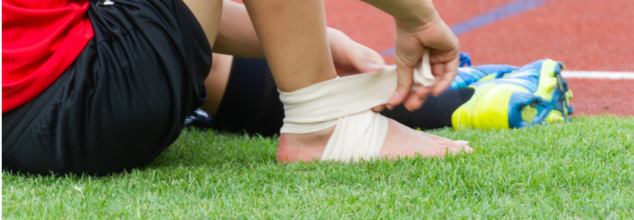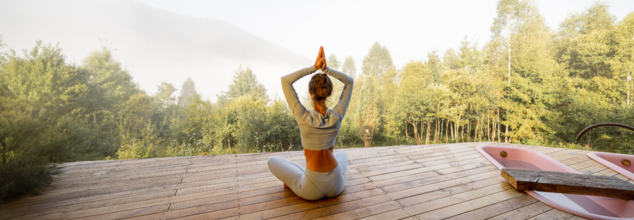
Sports Injury treatment (Credit: Canva)
How To Recover From Sports Injuries Faster With Targeted Physiotherapy
Sports injuries are a reality for all athletes. The difference for the weekend warrior and a professional competitor lies in the aspect of how long one waits for the road to recovery. However, targeted physiotherapy would drastically shorten the time it takes to heal so that you can return to your favorite activities sooner and stronger. Here's how it works.
Understanding the Role of Physiotherapy
While physiotherapy majorly deals with diagnosis and treatment followed by rehabilitation of injuries, the various techniques are meant to restore function and return an injured person's mobility. Ideally, upon identifying the specific nature of your injury, a physiotherapist can develop a tailored treatment plan that addresses your needs, as every injury has different recovery strategies.
Solution is Early Intervention
Early intervention is the best approach to recovery from sports injuries. The sooner one can seek treatment, the greater the recovery potential will be. Physiotherapists can provide modality applications like ice therapy, ultrasound, and electrical stimulation for reducing inflammation and pain; such an early treatment stage provides an excellent base for more thorough rehabilitation.
Tailor-Made Rehabilitation Programs
Once the acute phase is over, a physiotherapist will prepare a customized rehabilitation program. Commonly, this would include the following:
1. Strengthening Exercises: There are specifically targeted exercises to rebuild the muscle strength and endurance needed to support the injured area. In the case of an injury to a knee, these will strengthen the muscles surrounding it, thereby giving you greater stability and the likelihood of not experiencing similar injuries again.
2. Mobility and Flexibility Training: The muscles are stretched to improve the range of motion, which will be directly beneficial when returning to the game. If flexibility is lost a number of compensatory movements can arise and the possibility of a re-injury can increase.
3. Functional Training: These are exercises that actually look at the actual movement in your sport, and it aids confidence in recovering really to be able to thrive in sport. For instance, a basketball athlete who has been treated for an ankle injury will often have jumping and pivoting exercises as part of their treatment plan.
Techniques for Pain Management
Physiotherapy does not overlook the management of pain. For example, dry needling, manual therapy, and other specific mobilizations can help in relieving pain and promoting healing. Your physiotherapist will use them when needed while changing your treatment to suit your progress in recovery.
Education and Prevention
Education is often overlooked in physiotherapy. It is equally as essential to learn about your injury, the process of recovery, and how to avoid future problems. A good physiotherapist should provide you with the knowledge of proper techniques and routines for warm-up or conditioning in relation to your sport. This proactive approach will allow you to develop resistance against re-injury.
Continuous Monitoring and Readjustment
Recovery is not a straight line; sometimes it goes straight, and sometimes it makes some u-turns and detours. Consistent follow-ups with the physiotherapist enable tracking of the recovery process and measures to be undertaken in case any deviations are noticed. This flexibility ensures you are on course toward your goals without overstretching.

(Credit-Canva)
10 Minutes, Daily, Every Week: 8 Yoga Poses To Stay Fit And Healthy
Yoga has the ability to set the tone of your day. We see people who wake up super early, do a morning routine and squeeze in some yoga. This may seem like a hectic schedule to many, but exercising early in the morning has shown to be good for the mental as well as physical well-being of people. Experts explain that doing yoga every morning increases your energy, improves mental clarity, helps you reduce stress as well as ensure your physical well-being.
If you are worried about spending a dedicated time doing yoga, like an hour or so, you do not have to worry. Even spending 10 minutes, fully focused yoga can help you immensely. If you are doing these poses with guided videos, make sure you are not pushing yourself too hard, and proceed with caution. If you feel any odd discomfort, make sure you visit a healthcare professional just to be safe.
Child's Pose
Begin in Child's Pose, bringing your big toes together and knees wide for a comfortable stretch. Extend your arms forward, lifting onto your fingertips to deepen the stretch in your shoulders and armpits. Focus on expanding your ribcage with each inhale and relaxing your arms closer to the mat with each exhale, using your breath to settle into the pose.
Cat-Cow
Transition to Tabletop position, bringing your knees closer together. Flow through three rounds of Cat-Cow, arching your back on the inhale and rounding it on the exhale. This movement helps to gently mobilize and warm up your spine.
Leg Lifts and Variations
From Tabletop, lift your right leg, knee, and toes towards the ceiling on the inhale, and bring your knee to your nose on the exhale. Repeat twice, engaging your core. For an added challenge, lift your right leg again and reach back with your left hand to grab your right foot, deepening the backbend and stretching your left shoulder.
Modified Side Plank
With your right leg lifted, return your left hand to the mat, straighten your right leg, and roll onto the inner edge of your right foot into a modified Side Plank. Perform five toe taps, lifting and lowering your right leg, then bend your right knee to grab your right foot, deepening the backbend and shoulder stretch. Repeat the sequence on the left side.
Downward-Facing Dog
Move into Downward-Facing Dog, lifting your hips up and back, bending your knees as needed to lengthen your spine. From Down Dog, lift your right leg, bend your knee, and open your hip in Scorpion Dog.
Warrior 2 and Triangle Pose
Step your right foot forward into Warrior 2, grounding through your back foot and bending your front knee. Transition into Triangle Pose, straightening your right leg and reaching your right arm forward, then down, while your left arm extends upward. Explore variations to deepen the pose and strengthen your obliques.
Low Lunge and Quad Stretch
From Triangle Pose, move into Low Lunge, placing your back knee on the mat. Optionally, add a quad stretch by reaching back with your right hand to grab your left foot, pulling your heel towards your glutes. Repeat the sequence on the left side, then move back to Downward-Facing Dog.
Child's Pose and Seated Meditation
Return to Child's Pose, resting your hips towards your heels and extending your arms forward. Take five deep breaths, reflecting on your intention for the day. Transition into a comfortable seated position for a short meditation. Close your eyes, relax your shoulders, and soften your facial muscles. Focus on your breath and your intention for the day, grounding yourself before moving forward.

(Credit-Canva)
Relieve Your Emotional Exhaustion With These Yoga Poses
Being emotionally overwhelmed can be difficult to deal with. We all have such days when you are exhausted emotionally, it almost seems as if you are unable to do, even necessities. So, dealing with these issues often becomes the problem of how resilient you are and what tools you have learned. Here's where physical activities comes in. Harvard Health Publishing explains that exercising helps us reduce the levels of stress hormones such are adrenaline and cortisol.
Does yoga also play a part in better emotional regulation? Yes, ‘Yoga for better mental health’ by Harvard Health Publishing explains how yoga increases the release of endorphins, which are feel good chemicals your body produce as well as supplies more oxygenated blood in your brain.
Here are some yoga poses you can try if you are feeling emotionally exhausted. Make sure you are not overexerting yourself and practice precaution while performing the poses.
Supported Bridge Pose (Setu Bandha Sarvangasana Variation)
This pose provides deep relaxation by using props to support your body. It gently releases tension held in the upper back and shoulders, areas that often tighten when we experience stress or emotional strain. The support allows the nervous system to settle, promoting a sense of calm and release. Here’s how to do it.
- Lie comfortably on a bolster, a rolled-up blanket, or pillows which ensures your back is supported and your upper back is flat on the floor.
- Take slow, deep breaths, allowing your body to sink into the support.
- Stay in this pose for about 20 breaths, focusing on releasing tension.
Low Lunge Variation (Anjaneyasana Variation)
This variation opens up the front of your body, which tends to become hunched and closed off during periods of stress. The hands supporting the head create a gentle hammock, allowing your neck to relax and your chest to open. This helps to release emotional tension and promotes a feeling of openness and vulnerability.
- Step one foot forward into a low lunge position.
- Bring your hands behind your head, interlacing your fingers to support it.
- Gently lean back, opening your chest and throat.
- Hold this pose for approximately 5 breaths, focusing on the stretch in your front body.
Pyramid Pose Variation (Parsvottanasana Variation)
This pose utilizes gravity to release tension while simultaneously opening the chest and back. The addition of Gomukhasana arms provides extra support for a gentle forward bend. This combination allows for a deeper stretch, helping to release emotional and physical tightness, and promoting a sense of calm and groundedness.
- Stand with one foot stepped back, creating a wide stance.
- Use a strap or towel to perform Gomukhasana arms, and gently lean forward from your hips.
- Hold this pose for about 8 breaths, focusing on the stretch in your hamstrings and the opening in your chest.
Little Thunderbolt Pose Variation (Laghu Vajrasana Variation)
This pose lengthens the front of the body, stretching from thighs to throat, and encourages feelings of trust and surrender. It helps to release emotional blockages and promotes a sense of vulnerability, allowing you to let go of control and find inner peace.
- Kneel on the floor, using blocks behind you for support.
- Lean back, arching your spine and allowing your head to gently rest on the blocks.
- Repeat this movement, holding the pose for about 5 breaths each time, focusing on the stretch in your front body.
Reclining Tree Pose (Supine Vrksasana)
This is a gentle hip opener and lower back release, which also allows for a deeper opening of the chest. It helps to release tension in the hips and lower back, promoting a sense of calm and relaxation, and aiding in emotional release.
- Lie on your back, bring one heel toward your inner thigh, and allow your knee to open out to the side.
- Relax your arms and breathe deeply.
- Hold this pose for approximately 10 breaths, focusing on releasing tension in your hips and lower back.
Reclining Spinal Twist Variation (Supta Matsyendrasana Variation)
This gentle twist releases tension in the spine and promotes a sense of calm and relaxation. It helps to "wring out" emotional and physical tension, leaving you feeling refreshed and renewed. This pose also helps to improve flexibility and mobility in the spine.
- Lie on your back, drop your knees to one side, and turn your head in the opposite direction.
- Repeat this movement on the other side, holding each twist for a comfortable duration.
- This helps to release tension in your spine and promote relaxation.
Supported Legs Up the Wall Pose (Supported Viparita Karani)
This pose transforms feelings of pressure into softness, promoting deep relaxation and calm. It helps to relieve stress and anxiety, and promotes a sense of peace and tranquility. This pose is particularly effective for calming the nervous system and promoting restful sleep.
- Lie on your back, place a block or bolster under your hips, and raise your legs up the wall or toward the sky.
- Hold this pose for 3-5 minutes, allowing your body to fully relax and release tension.

Credits: Canva
These Are The Top 10 Fittest Cities Of America
There are many cities in the United States, however, not all of them are fit. In fact, the prevalence of obesity among adults aged 20 and older in the US was 40.3%. Severe obesity has affected 9.4% of adults, notes the Centers for Disease Control and Prevention (CDC). This is why the American College of Sports Medicine's (ACSM) 2024 American Fitness Index analyzed and ranked the 100 largest cities the United States to assess cities' overall fitness. The index was based on 33 fitness indicators. It considered factors like fruit and vegetable consumption, exercise habits, overall personal health, access to parks, playground, and recreational centers.
The ACSM ranked these 10 cities as the fittest of all
10. St Paul, Minnesota
At number 10th, we have St Paul. It was a population of 303,176 and has the most baseball diamonds per 10,000 residents of the 100 cities included in the report.
9. Irvine, California
This is a city in Orange County, which has ranked at the 9th for the US fitness index. It has a population of 313,685 and around 79% of the residents have exercised previous month. Out of them, 57.2% have also met the guidelines set for aerobic activity as per the American College of Sports Medicine and the CDC.
8. Atlanta, Georgia
Atlanta also joined the top 18 list at number 8 position with a population of 499,127. The city also performs well in regard to its citizens' health behaviors, with a high percentage of residents exercising in the last month. The citizens here also ranked highly for living within 10-miunte walking distance to a park.
7. Denver, Colorado
At seven, we have Denver, with the population of 713,252. It has also performed well with citizen's healthy behavior. 81.5% of its population exercised in the previous month.
6. Minneapolis, Minnesota
Second time in a row we have Minnesota, with its city Minneapolis at rank 6. It has a population 425,096. It is also in the index' highest ranked city for Bike Score, which measures whether a location is good for biking based on its bike infrastructure, geography and share of bicyclists. The city also ranks high for having parks within a 10-minute walk and for having a high percentage of residents who have exercised in the previous month.
5. Madison, Wisconsin
It has a population of 272,903 and the residents are mostly in good shape, reveals the survey. 55.1% of its residents are in excellent or very good health and 84.7% of its residents have exercised in the past month.
4. San Francisco, California
California is also making its mark the second time on the list. This time, it is with its 4th fittest city with the highest-ranked walk score among the 100 cities analyzed. It has a population of 808,437 and is the city with the lowest obesity rate. The rates are at 15.8% and 99% of its residents live within 10-minute walk to a park.
3. Seattle, Washington
It has a population of 749,256 and it prioritizes well-being. This is why it has earned the highest personal health ranking, which examines what people are doing individually to get and stay healthy.
2. Washington, D.C.
It has a population of 671,803. The city ranks first for the percentage of its population that consumes two or more fruits a day.
1. Arlington, Virginia
The first one to top the list is Arlington. This is for the seventh time in the row that Arlington has been ranked the fittest US city as per the American Fitness Index. It has ranked in top 10 in the 16 out of the 33 indicators. It has a population of 234,000. It has ranked best among the community and environment category, including for people exercising in the precious month, people sleeping 7+ hours a day, and the percentage of residents who smoke or live 10-minutes away from the park.
© 2024 Bennett, Coleman & Company Limited

